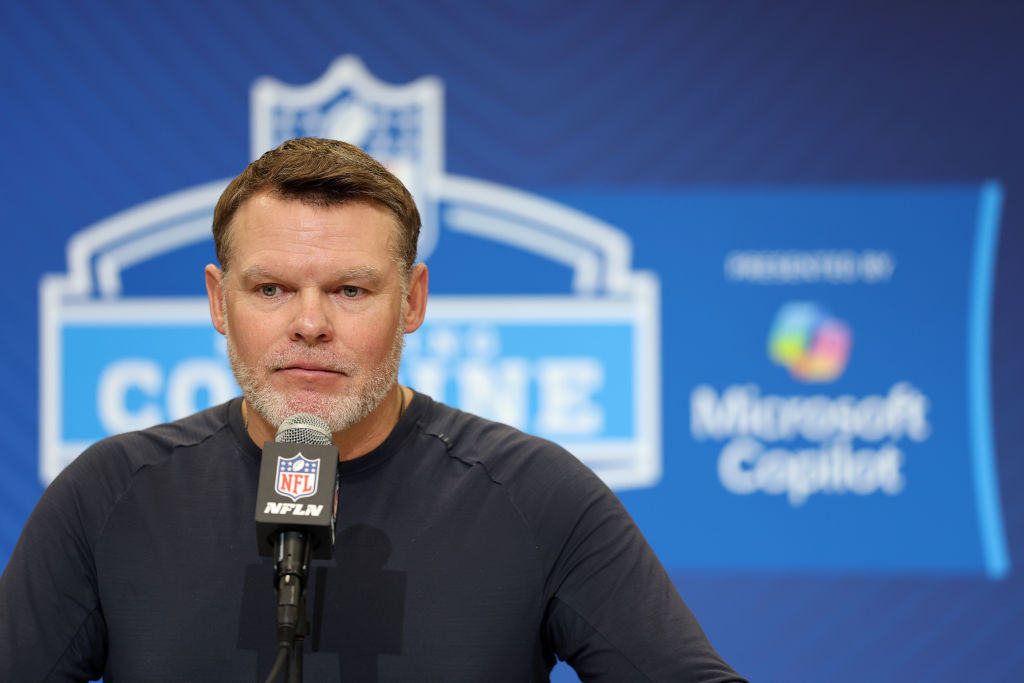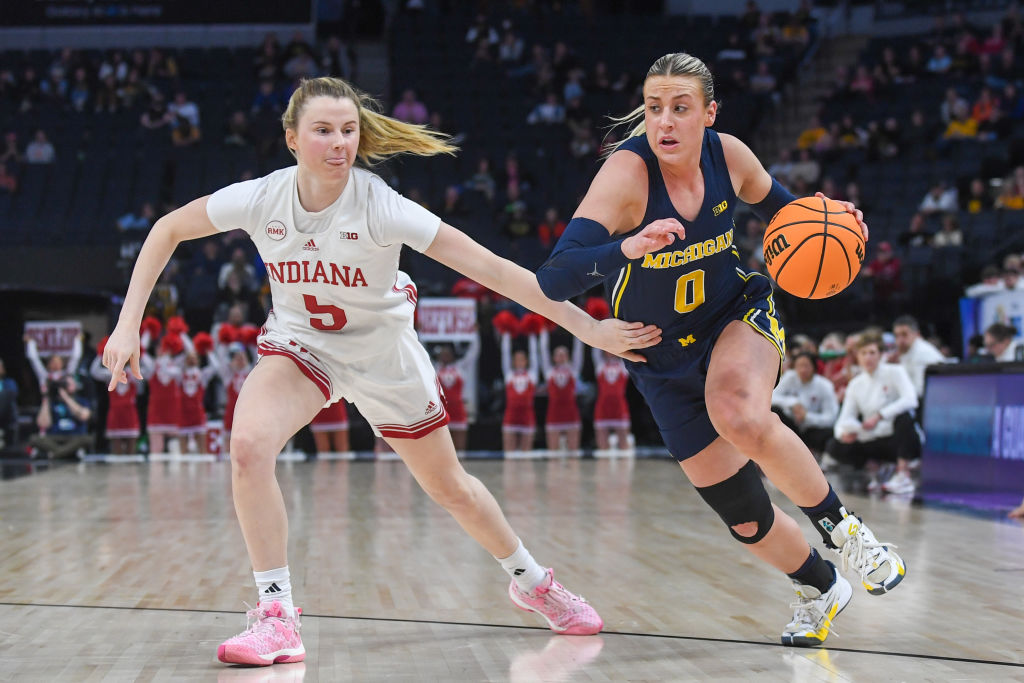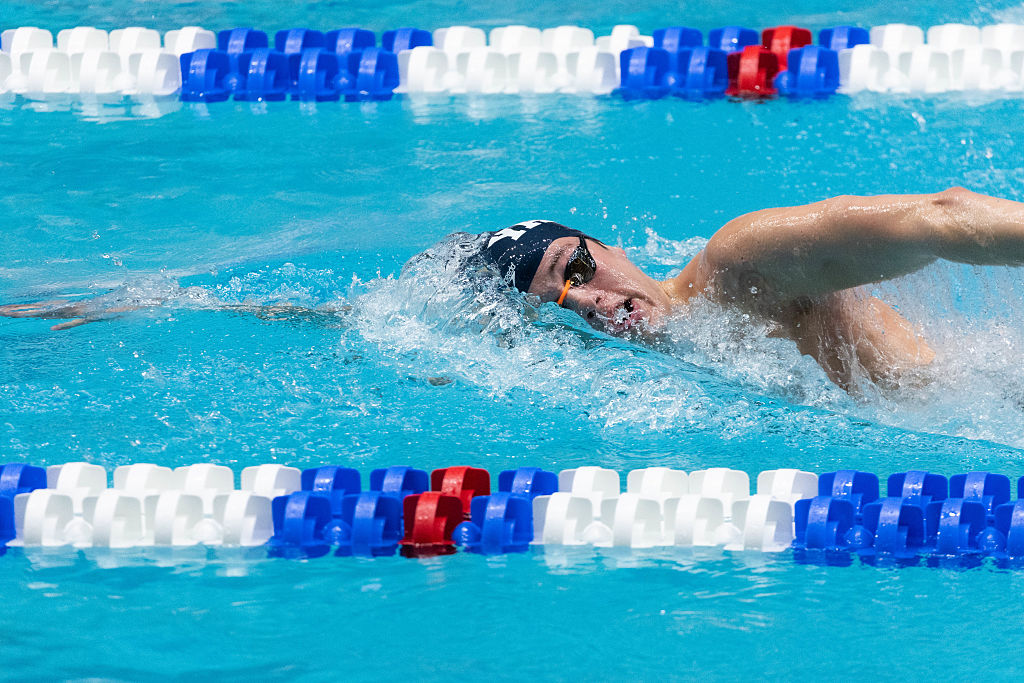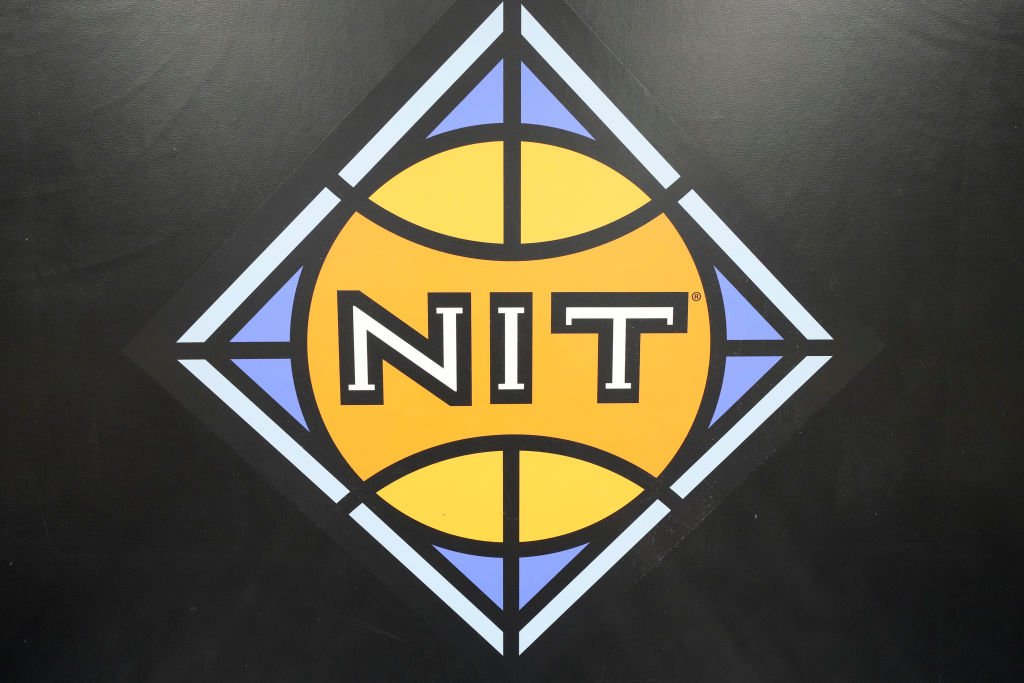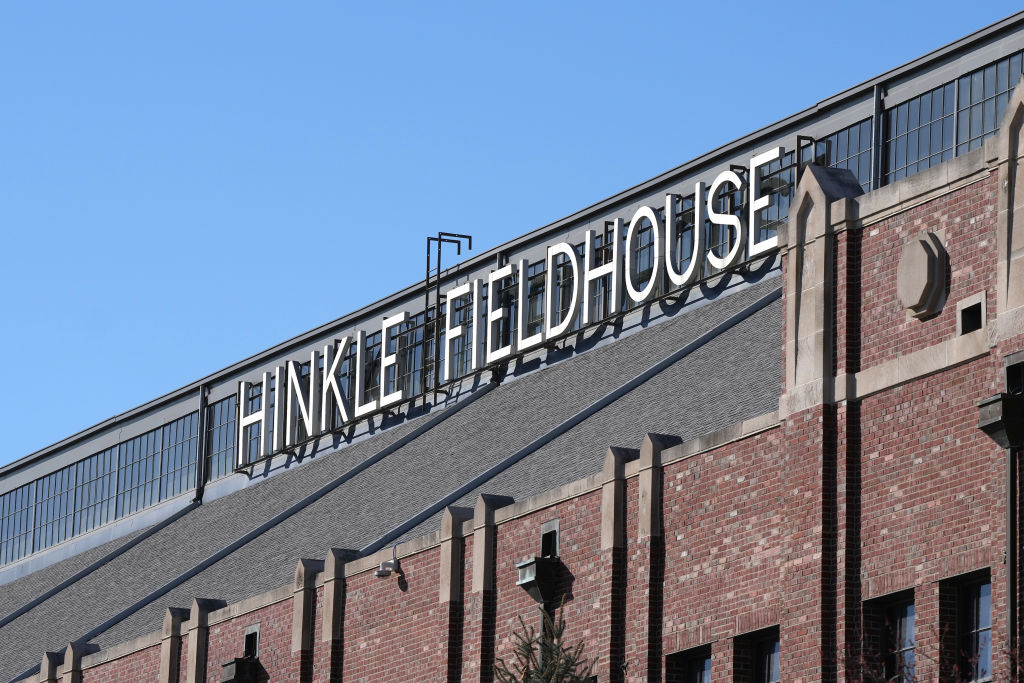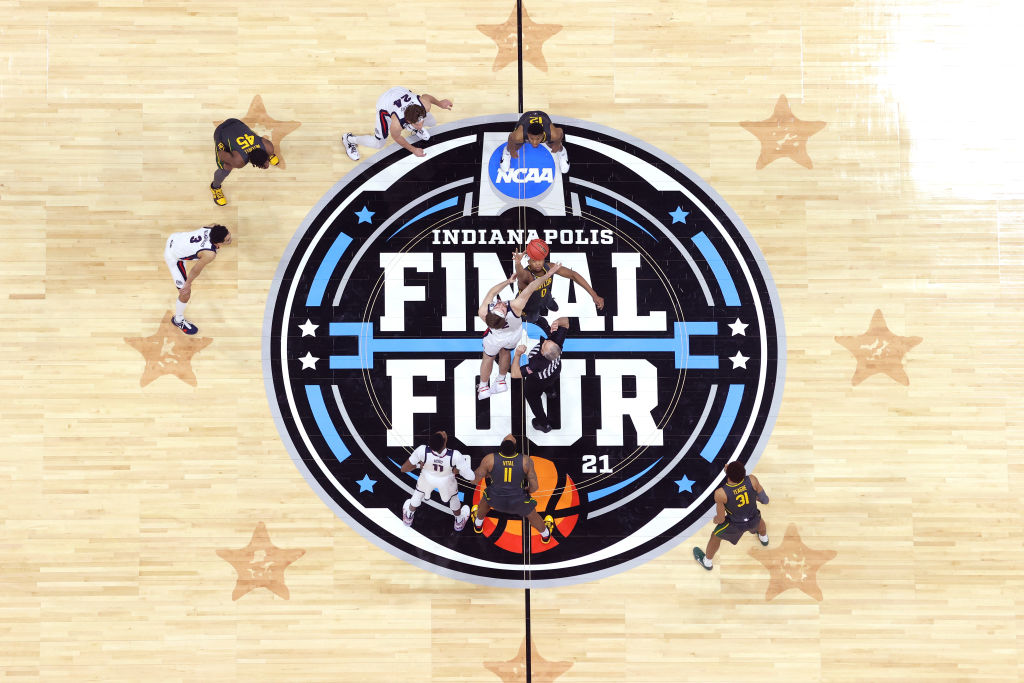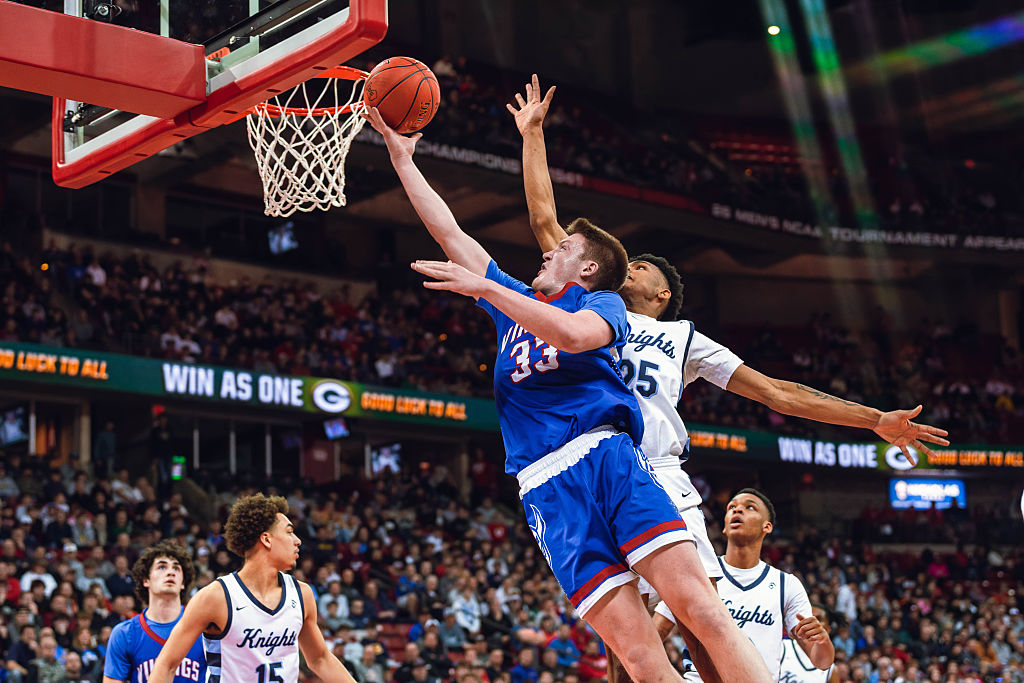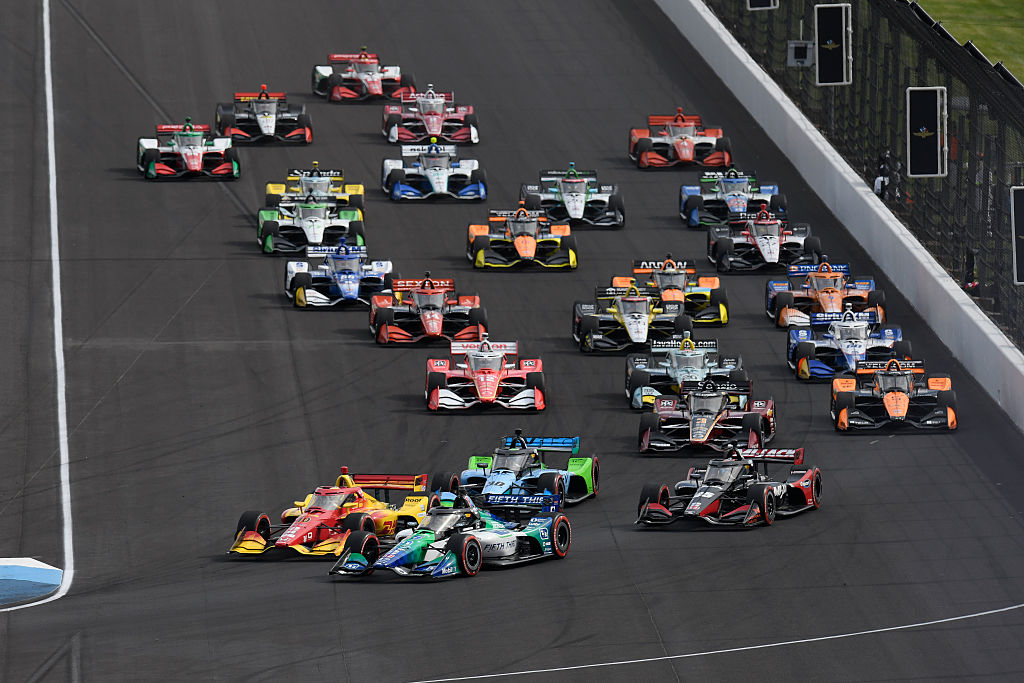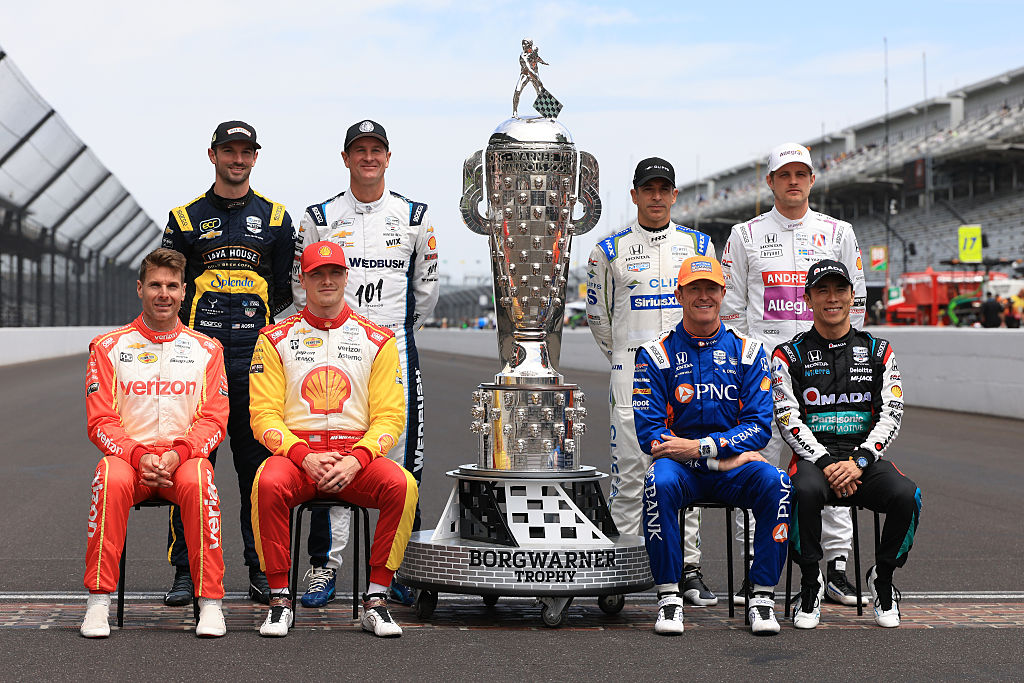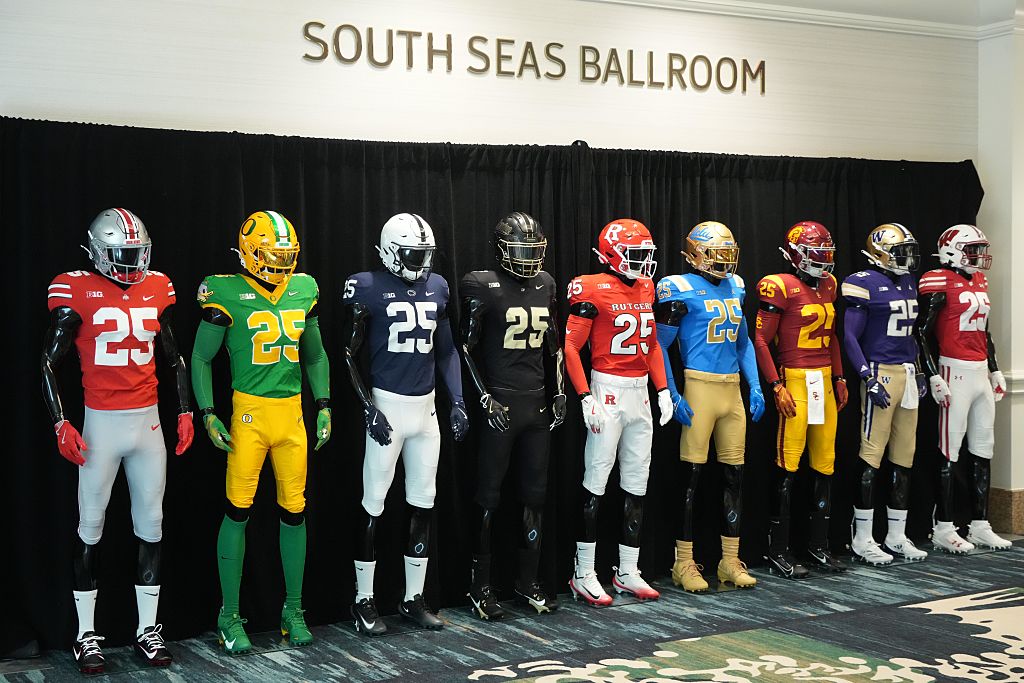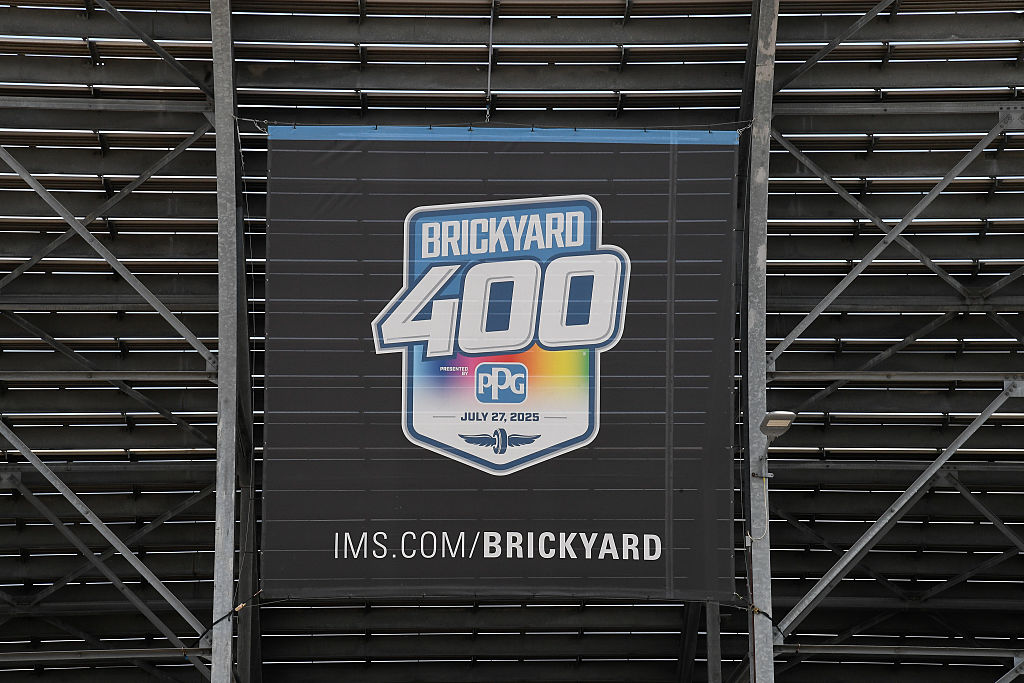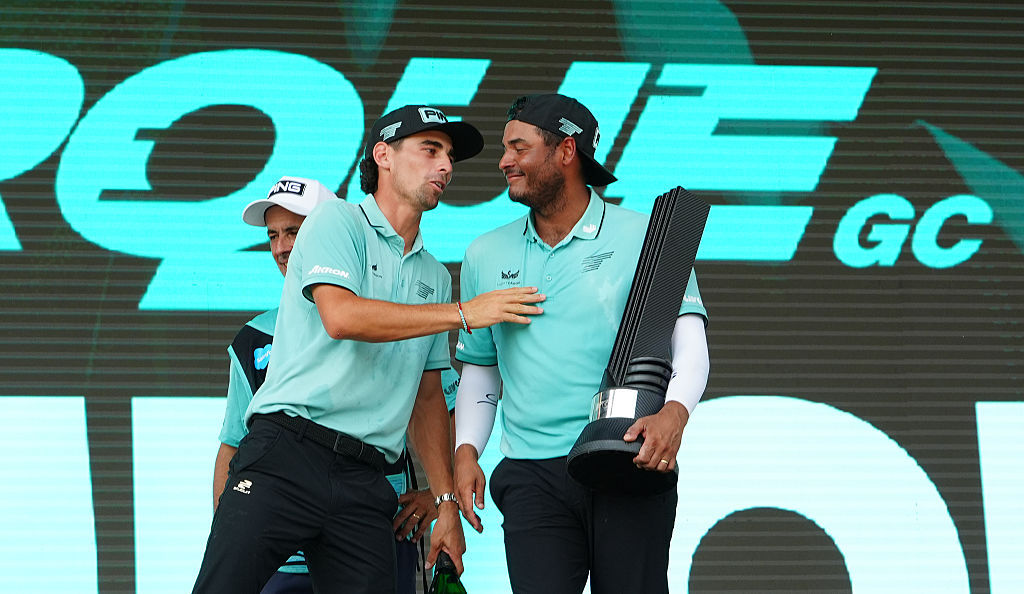Indianapolis, IN
The DIY Tour Guide Unearthing Overlooked Black History Right Where You're Standing

You don’t “meet” Sampson Levingston, as much as you experience him. My first encounter is in early April, on the weekend of the solar eclipse, in Indianapolis. He’s hosting a last-minute Walk and Talk Black History tour of Indiana Avenue—the neighborhood that was once a bustling hub of Black life and entrepreneurship—for the influx of tourists in town. Looking around our group of 15 or so he asks, “You’re all here for the eclipse?”
The former athlete and marketing major is upbeat and high energy, dressed in an oversized puffy black vest, and a jaunty yellow knit hat with blue pompoms sticking out from the sides (a remnant from the recent NBA All-Star Weekend, I later learn). Jazzy music wafts from his phone, which he amplifies with the microphone he uses to project to the group. He bounces while he stands in place, occasionally pulling out a dance move as he waits for the whole group to file in.
“I was immediately struck with just how passionate he was, the work that he does and the stories that he’s trying to tell, his unapologetic commitment to the truth even when that makes people uncomfortable,” says Ryan Huntley, a designer who moved to Indianapolis in 2006. Though Huntley was not on my particular tour, in his estimation he has participated in about 10 of Levingston’s offerings.
“I think that’s what I love the most about him— it’s that he’s not scared to make people uncomfortable. And he understands in moments of discomfort, things actually change.”
During the tour, which covers the avenue and a few side streets, Levingston holds up copies of the The Negro Motorist Green Book, a guide for roadtripping Black Americans published between 1936 and 1967 which catalogued safe spaces to eat, stay, and recreate. He points out where locations listed in the book would be today. He stops in front of the marker for the Senate Avenue YMCA, dedicated by Booker T. Washington and once one of the largest black YMCAs in the US. He asks if we can identify anyone in the mural of jazz musicians on the side of the 75-year-old Musicians’ Repair & Sales building on Capitol Avenue and tosses a bouncy ball if we get it right. He lists David Young, David Baker, JJ Johnson, Freddie Hubbard, and others who were instrumental in the city’s thriving jazz scene in the 1950s and 1960s and points out that their faces are painted on a shop that once supplied instruments to many of them.
He talks about the razing of the neighborhood once the “Big Trifecta” came in: a new interstate was built, along with a predominantly white university, combined with the expansion of a hospital. It’s this razing that Indianapolis residents are usually most surprised about, that Indiana Avenue didn’t always look the way they know it today. “A lot of people just assume that college campus has always been there or there was nothing there before the college campus,” says Levingston. “Figuring that out is powerful.”
Like many tours that launched in the pandemic, when people were figuring out how to play tourist in their own backyards, Levingston quickly found that local residents were interested what he had to offer. “People realized that there’s a lot in their city that they just don’t know,” says Levingston. The tours themselves were spurred by the Black Lives Matter protests—after attending one, Levingston was struck both by the energy of the crowd and the polarization of ideas. “I was like, ‘Man, I wish these people here knew a little bit about what I knew when it comes to Indianapolis,’” he says.
He’d always been interested in the city’s history, but previously kept his passion confined to a blog. When he decided to do a tour, he posted an announcement on Facebook. “I said, ‘For those that are interested in going downtown for the protests or don’t really know what to do, how about we do a walking history tour downtown and I can talk about what happened here in our neighborhood?’” he recalls. “It was a way to get people back together and let them know how Indianapolis fits in with the narrative of Black Lives Matter and restorative justice.”
Nineteen of his friends and family signed up, and somehow the local news station caught wind. They asked him to do another one so they could film footage. But during that filming, they asked him when the next tour would be. “I was like, ‘Uhhhh, Saturday,’” says Levingston. “So I went home and put more tickets up.”
When Levingston starts researching a new tour, he first thinks of a question he wants to answer, typically through the lens of the underdogs of history, whether it be Black figures, influential women, or indigenous heritage. He then looks at the records of the Indiana Historical Society and goes through back issues of newspapers in the Hoosier State Chronicles like the Indianapolis Recorder, which, established in 1865, is currently the fourth-longest running Black newspaper in the US.
History is about the unseen, he explains, a quality he likes. It reminds him of the waters that run under the city, literally what lies beneath. “I thought, man, I wonder what flows beneath the surface of me, this living, breathing, entity. What’s inside me that people don’t see, but is there?”
“I didn’t know that not everybody stops to read historical markers, or wondered why they were renaming the street.”
Levingston’s Indiana Avenue walking tour has now expanded to eight tours around the city, with more in the works. He does one-off themed walks for special occasions like All-Star Weekend and the recent Olympic team Swim Trials, held in Indianapolis. He’ll lecture at institutions like Newfields Art Museum, and do “Hawk and Talks” at local schools, covering everything from sports to nature.
The Indiana Avenue tour is the only one taken from a strictly Black history point of view, whereas the others are more of a “Sampson Levingston” lens. That is, whatever he finds the most compelling. It still surprises him that people seek out his knowledge and expertise. “I thought we just kind of knew this,” he says. “I didn’t know that not everybody stops to read historical markers, or wondered why they were renaming the street.”

We begin and end our tour near the corner of Indiana Avenue and Martin Luther King Jr., Blvd., where a large triangular brick building envelops the whole block. One one side there’s a protruding black marquee, lit with bulbs. The bricks are accented with green, red, and terra cotta designs and a sign that says WALKER THEATER, is propped up on top of the building in large red capital letters.
“The building was named for Madame C.J. Walker, a daughter of former slaves and the first self-made female millionaire in the world,” says Levingston. Considered the wealthiest Black woman and self-made woman in America at the time of her death in 1919, Walker made her fortune by developing and marketing cosmetics and hair care products for Black women.
The building was conceived as the corporate headquarters of the Madame C.J. Walker Manufacturing Community but by the time it opened the plans expanded to include a theater, movie house, drugstore, beauty salon, restaurant, and beauty school. It became a hub of the neighborhood, a community center bustling with commerce.
“She put the focus on Black people and Black women at a time where she kind of had to, but when it wasn’t quite expected for her to get that big doing what she did,” Levingston says, making it clear to me why he chose to begin and end his tour with this theater. “One thing I really admire about her is how she catered to her community.”
Want more Thrillist? Follow us on Instagram, TikTok, Twitter, Facebook, Pinterest, and YouTube.

Indianapolis, IN
Best available 2026 NFL free agents on defense for Indianapolis Colts

According to a few different rankings, here are the best available NFL free agent defenders for the Indianapolis Colts.
As the Indianapolis Colts attempt to get back to the playoffs for the first time since 2020, free agency will have to be a big part of that equation.
The Colts will have money to spend this offseason. According to Over the Cap, the Colts have $45.77 million in available cap space. Compared to the rest of the NFL, this is the ninth-most in football currently.
As GM Chris Ballard said on Thursday, salary cap-wise, the Colts are in “good shape.”
The Colts also have the ability to create more cap room if needed.
Last offseason, we saw Ballard take a much more aggressive approach in free agency. From the sounds of it, he will “continue down that path” this offseason.
There are always reasons to address just about every position group over the course of an offseason, but two specific areas Ballard mentioned on Thursday were the defensive front and getting faster on defense as a whole.
So, with a focus on the defense, specifically the front seven, here are the top available free agents this offseason at those positions.
Best available 2026 NFL free agents on defense for Indianapolis Colts
- DE Trey Hendrickson
- DE Jaelan Phillips
- IDL John Franklin-Myers
- LB Quay Walker
- LB Devin Lloyd
- DE Odafe Oweh
- DE Boye Mafe
- LB Nakobe Dean
- DE Joey Bosa
- IDL Travis Jones
- DE Khalil Mack
- LB Demario Davis
- DE Kyle Van Noy
- IDL Teair Tart
- IDL DaQuan Jones
*This list was compiled by rankings from Sports Illustrated, The Ringer, and Bleacher Report
Indianapolis, IN
Colts’ Chris Ballard: Daniel Jones has ‘really bright future in Indianapolis’

INDIANAPOLIS – Confidence remains high.
Carlie Irsay-Gordon made that clear Sunday night when she announced the Indianapolis Colts would move forward under the direction of general manager Chris Ballard and coach Shane Steichen.
And Ballard reinforced that conviction during Thursday’s postscript following an 8-9 record and fifth consecutive season without a playoff appearance.
“It wasn’t all negative,’’ he insisted. “I mean, 8-2 is real.
“That was not a mirage. It wasn’t. We were humming. We were playing good football.’’
After outlasting the Atlanta Falcons in overtime in Berlin Nov. 9, the Colts returned home 8-2.
“I mean, I would have told you when we got back from Germany . . . we had a top-four team in the league,’’ Ballard said. “I believe that. Still believe that.
“But losing seven in a row is losing seven in a row. That’s not what top-four teams do. And that’s reality. That’s the facts.’’
Here’s another undeniable fact: The Colts’ confidence moving forward is rooted in Daniel Jones.

Simple as that.
Yes, the edge pass rush wasn’t nearly good enough and a legitimate bookend for Laiatu Latu is critical. A free-agent acquisition should be a priority.
Yes, the defense must, as Ballard stressed, get younger and faster. The 2026 front-seven won’t resemble the 2025 front-seven.
And yes, the Colts must be able to run the ball better even when situations aren’t favorable. During the seven-game losing streak, which was fueled by injuries to Jones, Jonathan Taylor averaged 63.7 yards per game and 3.3 per attempt.
But if Jones isn’t the answer, nothing much else matters.
There are two significant issues with Jones that would be major impediments to a continued relationship in any other scenario.
Jones:
- Will be an unrestricted free agent in March.
- Tore his right Achilles Dec. 7, underwent surgery Dec. 9 and faces an arduous rehab. He expects to be ready for the start of training camp in late July. That would represent an 8½-month rehab.
“We’ll attack the process and make sure I’m ready to go,’’ Jones said Monday.
“I’m not a doctor and I’m not God in terms of knowing what the future is going to hold in his healing,’’ Ballard said. “ . . . the history of guys coming back has been pretty good and they’ve been older than Daniel.
“He’s a pretty freaky talent in terms of athletic ability. So no, I do feel confident that he will make it back. Will he be the version you saw (last season) right away? Maybe not, but he’s still going to be really good. I think as he goes along and plays, he’ll be fine.
“I know . . . he’s going to give every ounce of his being into being the best he can be to be ready.’’
But first things first, and that means signing him to an extension.
At the risk of assuming too much, that almost assuredly will be done.
“I’d love to be back here,’’ Jones said.
The feeling is mutual.
Ballard was asked if the Colts were committed to retaining Jones “come hell or high water.’’
He smiled.
“Well, hell or high water is a strong word, but we would like . . . it’s mutual on both sides,’’ he said. “I think Daniel was a really good fit for this organization and I think this organization and city were a really good fit for Daniel.’’
A multi-year deal could mirror that of contracts secured by Sam Darnold in Seattle (three-years, $100.5 million, $55 million guaranteed) or Baker Mayfield in Tampa Bay (three years, $100 million, $50 million guaranteed).
Ballard admitted Jones’ Achilles injury and rehab will impact negotiations, “but we’ll work through that with his agent. He’s got a really good agent.
“We’ll find a way to work through that.’’
If common ground can’t be reached – that probably means guaranteed money – the Colts always could use the franchise tag to retain Jones. The projected 2026 tag for quarterbacks is roughly $46 million guaranteed.
Jones turns 29 in May, which can be the midpoint of a quarterback’s career.
A reinvestment in Jones will represent short- and long-term stability at a position that’s been in flux since Andrew Luck’s sudden retirement two weeks before the 2019 season.
“I’m looking at him both: Near and long,’’ Ballard said. “And I think that helps us. I mean, I’ve been very stated about like when you’re chasing the quarterback all the time, it makes it very . . . it’s hard. Like, your margin for error really shrinks down.
“And I feel very good about Daniel Jones and where he’s at, where he’s going. Yes, he’s got the Achilles, but I think Daniel Jones has got a really bright future here in Indianapolis. And look, there is some comfort knowing that, okay, we know we’ve got a guy that’s proven, that’s done it, and done some really good things.
“So, that does give you some confidence.’’
Until Jones fractured his left fibula then tore his right Achilles, he had distanced himself from his inconsistent and error-prone six seasons with the New York Giants. You remember, right? One playoff appearance was overshadowed by a 24-44-1 record as a starter and 70 turnovers.
Through the Colts’ 8-2 start, Jones was among the NFL’s most productive and efficient quarterbacks: 3rd in yards (2,659) and completion percentage (69.9) and 5thin yards per attempt (8.3). He joined Peyton Manning as the only player in franchise history to pass for at least 200 yards in each of his first 10 starts.
Jones completed 68% of his passes, averaged 8.1 per attempt and finished with a 100.2 rating. All were career highs.
“I’ll give Shane and the offensive staff a lot of credit,’’ Ballard said, “playing to his strength. He is really accurate with the football, okay, and he’s very smart and decisive of where he plays with the football.’’
What about Richardson?
The team’s undeniable commitment to Jones brings into question Anthony Richardson Sr.’s future with the Colts. He’s under contract through next season – there’s no reason to believe the team will exercise his fifth-year option – and finished the season on the injured reserve.

Richardson underwent surgery to repair a fractured right orbital bone after a freak accident with a resistance band before the Oct. 12 game with Arizona.
“Unfortunately for Anthony, he’s had some really bad luck,’’ Ballard said.
The No. 4 overall pick in 2023 has missed 29 of a possible 51 games because of a variety of injuries.
Richardson lost a training camp competition with Jones and was on the field for just 14 snaps in two games. He practiced the last three weeks but still was experiencing some degree of vision issues.
“He’s got to still work through the vision he has and we’ll see what the future holds there,’’ Ballard said. “We’ll kind of see going forward how that ends up playing out.
“A lot of it’s going to deal with his health, too.’’
Acquiring a late-round pick in a trade for Richardson shouldn’t be ruled out.
He is confident he’ll experience success.
“Oh yeah, no doubt,’’ he said. “If I’ve still got a chance to play football, it is always out there for me.’’
The Colts could consider Richardson expendable after seeing Riley Leonard play reasonably well as a rookie. If there is a concern that Jones won’t be ready for the season opener in September, they could bring in a veteran with starter experience in the offseason.
“Yeah, we’ll work through that,’’ Ballard said. “That is something we will evaluate. We got to make the decision. ‘Okay, if Anthony doesn’t get to where we think he can be, can Riley be the 2?’
“I do think it’s a position that every year we’ve got to address in some way, fashion or form.’’
You can follow Mike Chappell on Twitter at @mchappell51.
Indianapolis, IN
Indianapolis Sports Calendar 2026: Final Four, Indy 500 & More
-

 Detroit, MI6 days ago
Detroit, MI6 days ago2 hospitalized after shooting on Lodge Freeway in Detroit
-

 Technology3 days ago
Technology3 days agoPower bank feature creep is out of control
-

 Dallas, TX4 days ago
Dallas, TX4 days agoDefensive coordinator candidates who could improve Cowboys’ brutal secondary in 2026
-

 Health5 days ago
Health5 days agoViral New Year reset routine is helping people adopt healthier habits
-

 Iowa3 days ago
Iowa3 days agoPat McAfee praises Audi Crooks, plays hype song for Iowa State star
-

 Nebraska3 days ago
Nebraska3 days agoOregon State LB transfer Dexter Foster commits to Nebraska
-

 Nebraska3 days ago
Nebraska3 days agoNebraska-based pizza chain Godfather’s Pizza is set to open a new location in Queen Creek
-

 Oklahoma1 day ago
Oklahoma1 day agoNeighbors sift debris, help each other after suspected Purcell tornado









